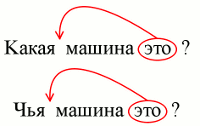One of the little difficulties for us foreigners studying Russian is to figure out when we need to change это to agree with a noun, and when not. It's confusing because really there are two different это words in Russian. The first we will call “unchanging это,” which has only one form, and the other we will call “adjectival это,” which has endings that change for case, number, and gender. The neuter singular form of adjectival это is spelled the same as unchanging это, and that's where the confusion is born.
Unchanging это
Unchanging это is first of all used in the phrase «Что это?», which can be translated quite a few ways, depending on the number of things the questioner is asking about:
| Что это? | What is this? What is that? What are these? What are those? |
Likewise in the response to those questions, это can be translated quite a few ways:
| Это — журнал. | This is a magazine. That is a magazine. |
| Это — книга. | This is a book. That is a book. |
| Это — письмо. | This is a letter. That is a letter. |
| Это — журналы. | These are magazines. Those are magazines. |
Similarly, unchanging это is also used in the phrase «Кто это?», which can be translated quite a few ways, depending on the number of things the questioner is asking about:
| Кто это? | Who is this? Who is that? |
Likewise in the response to those questions, это can be translated quite a few ways:
| Это — мой брат. | This is my brother. That is my brother. |
| Это — моя сестра. | This is my sister. That is my sister. |
| Это — мои друзья. | These are my friends. Those are my friends. |
Thus unchanging это can be translated as this, that, these, or those, depending on context. Now notice that in the English translations of those sentences above, whenever we are dealing with unchanging это, the this/that/these/those in English is separated from the noun it refers to by a form of the verb “to be.” That's going to be our rule of thumb for identifying unchanging это:
Rule of thumb: When “this” (or that/these/those) is separated from its noun by a form of “to be” in English, use unchanging это in Russian.
Unchanging это also appears in какой and чей questions. Here there is a quirk in Russian word order. For instance, an American might expect the translation of “What kind of car is that?” to be «Какая машина это?», where какая agrees with машина in gender and number, and where we use unchanging это because “that” is separated from машина by “is.” That's true as far as it goes. But for some reason the Russians always like to move the это to a position immediately after the question word:

Adjectival это
As to adjectival это, it has the following forms in the nominative case:
| Masc | Neut | Fem | Pl | |
| Nom | этот | это | эта | эти |
We use adjectival это to directly modify a noun. When translating adjectival это, there is no form of the verb “to be” between this-these and its noun:
| Эта книга очень интересная. | This book is very interesting. |
| Этот студент говорит по-русски. | This student speaks French. |
| Эти люди живут в Москве. | These people live in Moscow. |
| Это письмо очень интересное. | This letter is very interesting. |
Adjectival это is also used in phrases equivalent to colloquial English “this one,” “that one” and “these ones”:
| Вот батончики. Этот — мой, а тот — твой. | Here are the candy bars. This one is for me, and that one is for you. |
| Та фотография — красивая, а эта — некрасивая. | That photo is pretty, a this one is ugly. |
| Это общежитие — новое, а то — старое. | This dorm is new, and that one is old. |
| Те студенты — русские, а эти — американцы. | Those students are Russians, and these ones are Americans. |